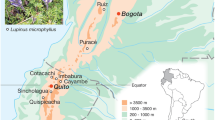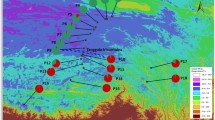Abstract
The genus Caragana (Fabr.) in the Ordos Plateau of Inner Mongolia, China, provides a strong opportunity to investigate patterns of genetic differentiation along steep climatic gradients, and to identify the environmental factors most likely to be responsible for driving the radiation. This study used a factorial, multi-model approach to evaluate alternative hypotheses and identify the combination of environmental factors that appear to drive genetic divergence of Caragana in the Ordos Plateau. We had three specific hypotheses. First, we expected that gradients of changing climate would act as resistant factors limiting gene flow, and would provide stronger prediction of genetic differentiation than isolation by distance. Second, we expected that variation in precipitation would be a stronger predictor of genetic differentiation among populations than variation in temperature. Third, we expected that the pattern of phylogenetic differences, in terms of derived versus ancestral states of rachis and leaf shape, would be highly correlated with these gradients of changing precipitation, reflecting adaptive radiation along gradients of changing precipitation driven by reduced gene flow and differential patterns of directional selection. As we expected, variation in precipitation was a much stronger predictor of genetic differentiation than were other climatic variables or isolation by distance. The pattern of phylogenetic differentiation among Caragana species is also closely associated with gradients of changing patterns of precipitation, suggesting that differential precipitation plays a major role in driving the genetic differentiation and adaptive radiation of the Caragana genus in the region of the Ordos Plateau.



Similar content being viewed by others
References
Amos J, Bennet AF, Mac Nally R, Newell G, Radford JQ, Pavlova A, Thompson J, White M, Sunnucks P (2012) Predicting landscape genetic consequences of habitat loss, fragmentation and mobility for species of woodland birds. Plos One 7:e30888
Bai J, Ge QS, Dai JH, Wang Y (2010) Relationship between woody plants phenology and climate factors in Xi’an, China. Chin J Plant Ecol 34(11):1274–1282
Chang ZY, Zhang ML (1997) Anatomical structures of young stems and leaves of some Caragana species with their ecological adaptabilities. Bull Bot Res 17:66–71
Chen XD, Dong XJ, Chen ZX (1999) Shrub diversity and its restoration ecology in Ordus Plateau Sandland. In: Ma KP (ed) Ecosystem diversity in key areas of China. Zhejiang Science and Technology Press, Hangzhou, pp 109–153
Coyne JA, Orr AH (2004) Speciation. Sinauer Associates, Sunderland
Cushman SA, Landguth EL (2010) Spurious correlations and inference in landscape genetics. Mol Ecol 19:3592–3602
Cushman SA, McKelvey KS, Hayden J, Schwartz MK (2006) Gene-flow in complex landscapes: testing multiple models with causal modeling. Am Nat 168:486–499
Cushman SA, Wasserman TN, Landguth EL, Shirk AJ (2013) Re-evaluating causal modeling with Mantel Tests in landscape genetics. Diverstiy 5:51–72. doi:10.3390/d50x000x
de León LF, Bermingham E, Podos J, Hendry AP (2010) Divergence with gene flow as facilitated by ecological differences: within-island variation in Darwin’s finches. Philos Trans R Soc B 365:1041–1052
Doebeli M, Dieckmann U, Metz JA, Tautz D (2005) What we have also learned: adaptive speciation is theoretically plausible. Evolution 59:691–695
Dong GY, Li BS, Gao SY (1983) The Quaternary ancient ecolian sands in the Ordos Plateau. Acta Geogr Sin 38(4):341–347
Dormer EJ (1945) An investigation of the taxonomic value of shoot structure with special references of the Leguminosae. Ann Bot N S 9:141–161
Doyle J (1999) DNA protocols for plants: CTAB total DNA isolation. In: Hewitt GM, Johnston A (eds) Molecular techniques in taxonomy. Springer, Berlin, pp 283–293
Editorial Committee of Flora Reipublicae Popular Sinicae, Chinese Academy of Science (1993) Flora of China (42 vol part 1). Science Press, Beijing, pp 13–67
Ennos RA (1994) Estimating the relative rates of pollen and seed migration among plant populations. Heredity 72:250–259
Feder JL, Hunt TA, Bush L (1993) The effects of climate, host plant phenology and host fidelity on the genetics of apple and hawthorn infesting races of Rhagoletis pomonella. Entomol Exp Appl 69:117–135
Gavrilets S (2000) Waiting time to parapatric speciation. Proc R Soc B 570(267):2483–2492
Gavrilets S, Vose A (2007) Case studies and mathematical models of ecological speciation. 2. Palms on an oceanic island. Mol Ecol 16:2910–2921
Gavrilets S, Li H, Vose MD (2000) Patterns of parapatric speciation. Evolution 54(1126–559):1134
Gorbunova NN (1984) De generis Caragana Lam. (Fabaceae) notae systematicae. Novosti Sist Vyssh Rast 21:92–100
Grubov VI (1999) Plants of Central Asia, vol 1. Science Publishers, Inc., New Hampshire
Guillot G, Rousset F (2011) On the use of simple and partial Mantel tests in the presence of spatial auto-correlation. arXiv:1112.0651v1
Guo ZX, Zhang XN, Wang ZM et al (2012) Responses of vegetation phenology in Northeast China to climate change. Chin J Ecol 29(3):578–585
Hijmans RJ, Cameron SE, Parra JL, Jones PG, Jarvis A (2005) Very high-resolution interpolated climate surfaces for global land areas. Int J Climatol 25:1965–1978
Hoelzer GA, Drewes R, Meier J, Doursat R (2008) Isolation-by-distance and outbreeding depression are sufficient to drive parapatric speciation in the absence of environmental influences. PLoS Comput Biol 4:e1000126
Iverson LR, Prasad AM (2002) Potential redistribution of tree species habitat under five climate change scenarios in the eastern US. For Ecol Manag 155:205–222
Komarov VL (1908) Generis Caragana monographia. Acta Hortic Petrop 29:77–388
Komarov VL (1945) VL Komarov Opera Selecta. Academic Science Press URSS, Moscow, pp 159–342
Kremer A, Ronce O, Robledo-Arnuncio JJ et al (2012) Long-distance gene flow and adaptation of forest trees to rapid climate change. Ecol Lett 15:378–392
Kutzbach JE, Prell WL, Ruddiman WF (1993) Sensitivity of Eurasian Climate to surface up lift of the Tibetan Plateau. J Geol 101:177–190
Legendre P, Fortin M-J (2010) Comparison of the Mantel test and alternative approaches for detecting complex multivariate relationships in the spatial analysis of genetic data. Mol Ecol 10:831–844
Li B (1990) Natural resources and environment research in Ordos Plateau, Inner Mongolia. Science Press, Beijing
Li XR (1997) The characteristics of the flora of the shrub resource in Maowusu Sandland and the countermeasures for their protection. J Nat Res 12:146–152
Li XR (2000) Discussion on the characteristics of shrubby diversity of Ordos Plateau. Resour Sci 22:54–59
Liu XD, Li L, An ZS (2001) Tibetan Plateau uplift and drying in Eurasian interior and Northern Africa. Quat Sci 21(2):114–122
Ma YQ (1989) Flora of Inner Mongolia, vol 3, 2nd edn. The Peoples Press of Inner Mongolia, Hohhot
Ma CC, Gao YB, Liu HF (2003) Interspecific transition among Caragana microphylla, C. davazamcii and C. korshinskii along geographic gradient. I. Ecological and RAPD evidence. Acta Bot Sin 45:1218–1227
Manabe S, Broccoli AJ (1990) Mountains and arid climates of middle latitudes. Science Press, Beijing, pp 192–194
Manabe S, Terpstra TB (1974) The effects of mountain s of the general circulation of the atmosphere by numerical experiments. J Atmos Sci 31:3–42
Mantel N (1967) The detection of disease clustering and a generalized regression approach. Cancer Res 27:209–220
Mayr E (1954) Change of genetic environment and evolution. In: Huxley J, Hardy AC, Ford EB (eds) Evolution as a process. Allen & Unwin, London, pp 157–180
McKinnon JS, Mori S, Blackman BK, David L, Kingsley DM et al (2004) Evidence for ecology’s role in speciation. Nature 429:294–298
Meirmans PG (2012) The trouble with isolation by distance. Mol Ecol 21:2839–2846
Nei M (1972) Genetic distance between populations. Am Nat 106:282–292
Niemiller ML, Fitzpatrick BM, Miller BT (2008) Recent divergence-with-gene-flow in Tenessee cave salamanders (Plethodontidae; Gyrinophylus) inferred from gene genealogies. Mol Ecol 17:2258–2275
Nix H (1986) A biogeographic analysis of Australian elapid snakes. Atlas of Elapid Snakes of Australia. Australian Government Publishing Service, Canberra
Nosil P (2008) Speciation with gene flow could be common. Mol Ecol 17(2103–540):2106
Rehfeldt GE, Crookston NL, Warwell MV, Evans JS (2006) Empirical analyses of plant-climate relationships for the western United States. Int J Plant Sci 167(6):1123–1150
Sanczir CZ (1979) Genus Caragana Lam. (systematic, geography, phylogeny and economic significance). In: Study on flora and vegetation of P. R. Mongolia, vol. 1. Academic Press, Ulan-Bator, pp 233–388
Smouse PE, Long JC, Sokal RR (1986) Multiple regression and correlation extensions of the Mantel test of matrix correspondence. Syst Zool 35:627–632
Song CQ, You SC, Ke LH, Liu GH, Zhong XK (2012) Phenological variation of typical vegetation types in northern Tibet and its response to climate changes. Acta Ecol Sin 32(4):1045–1055
Wasserman TN, Cushman SA, Schwartz MK, Wallin DO (2010) Spatial scaling and multi-model inference in landscape genetics: Martes americana in northern Idaho. Landscape Ecol 25:1601–1612
Wiley EO (1991) The compleat cladist: a primer of phylogenetic procedures. Special publication no. 19. The University of Kansas Museum of Natural History, Lawrence
Wright S (1932) The roles of mutation, inbreeding, cross breeding and selection in evolution, vol 1. In: Proceedings of the sixth international congress of genetics, pp 356–366 For more recent reviews of Wright’s theory, see S. Wright [Evolution 36,427 (1982)] and W. Provine [Sewall Wright and Evolutionary Biology (University of Chicago Press, Chicago, 1986)]
Wu ZY (1980) Vegetation of China. Science Press, Beijing
Yamamoto S, Sota T (2009) Incipient allochronic speciation by climatic disruption of the reproductive period. Proc R Soc B 276:2711–2719
Yang CY, Li N, Ma XQ (1990a) The floristic analysis of genus Caragana. Bull Bot Res 10(4):93–99
Yang HY, Li N, Ma Q (1990b) The floristic analysis of genus Caragana. Bull Bot Res 10:93–99
Yang JY, Yang J, Yang MB et al (2012) Genetic diversity of Caragana species of the Ordos Plateau in China. Plant Syst Evol 298:801–809
Ye DZ, Gao YX (1979) Meteorology of Qinghai-Xizang Plateau. Science Press, Beijing, pp 1–278
Yeh FC, Yang RC, Boyle T (1999) POPGENE 32-version 1.31. Population Genetics Software. http://www.ualberta.ca/~fyeh/fyeh/
Yue LP, Li JX, Zheng GZ (2007) The Ordos Plateau evolution and environmental effect. Earth Sci 37:16–22
Zhang ML (1997) A reconstructing phylogeny in Caragana (Fabaceae). Acta Bot Yunnan 19:331–341
Zhang ML (1998) A preliminary analytic biogeography in Caragana (Fabaceae). Acta Bot Yunnan 20:1–11
Zhang ML, Tian XY, Ning JC (1996) Pollen morphology and its taxonomic significance of Caragana Fabr. (Fabaceae) from China. Acta Phytotaxon Sin 34:397–409
Zhang ML, Huang YM, Kang Y et al (2002) Floristics and vegetation of the genus Caragana in Ordos Plateau. Bull Bot Res 22:497–502
Zhou DW (1996) Study on distribution of the genus caragana Fabr. Bull Bot Res 16(4):428–435
Zhou DW, Wang AS, Li H (1994) Classification and distribution of Sect. Caragana, Caragana. J Northeast Norm Univ 2:64–68
Zhou DW, Liu ZL, Ma YQ (2005) The study on phytogeographical distribution and differentiation of Caragana Fabr., Leguminosae. Bull Bot Res 25(04):471–487
Acknowledgments
This work was supported by Science Foundation of Ministry of Science and Technology of China (2011BAC07B01).
Author information
Authors and Affiliations
Corresponding author
Rights and permissions
About this article
Cite this article
Yang, J., Cushman, S.A., Yang, J. et al. Effects of climatic gradients on genetic differentiation of Caragana on the Ordos Plateau, China. Landscape Ecol 28, 1729–1741 (2013). https://doi.org/10.1007/s10980-013-9913-x
Received:
Accepted:
Published:
Issue Date:
DOI: https://doi.org/10.1007/s10980-013-9913-x




